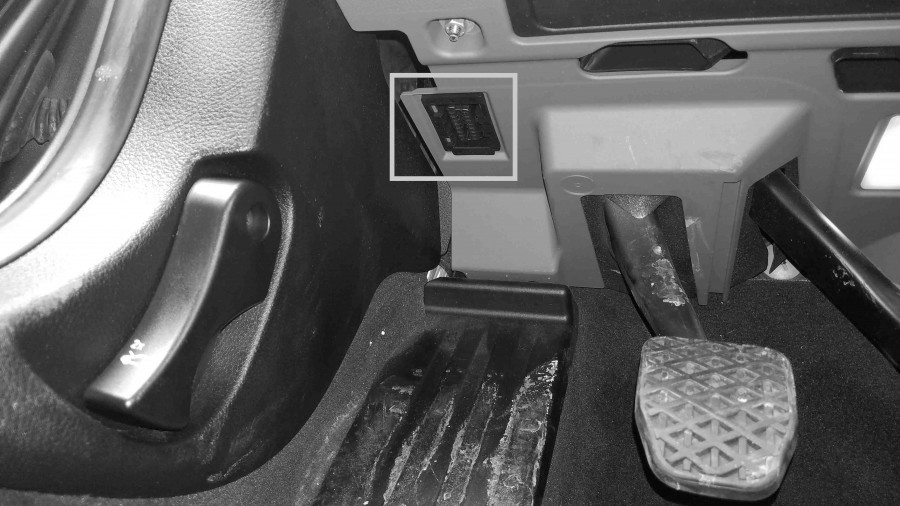The On-Board Diagnostic II (OBD2) port in your 2012 Chrysler 300 is a crucial access point for vehicle diagnostics and maintenance. Whether you’re looking to read fault codes, check sensor data, or reset that persistent check engine light, knowing the location of this port is the first step. Fortunately, accessing the OBD2 port in your 2012 Chrysler 300 is typically straightforward.
Locating the OBD2 Port in Your 2012 Chrysler 300
In the 2012 Chrysler 300, as with most modern vehicles, the OBD2 port is strategically positioned for easy access from the driver’s seat. You’ll find it nestled beneath the dashboard on the driver’s side of the vehicle. Specifically, it’s situated above the brake pedal and to the left of the steering column. This standard location makes it convenient to connect a diagnostic scanner without needing to contort yourself or search in obscure places.
This standardized port is part of the On-Board Diagnostic II (OBD-II) system, a vital tool for diagnosing a wide range of vehicle issues. By connecting an OBD-II scanner to this port, you or a mechanic can effectively diagnose problems related to the engine, transmission, ABS, airbag systems, and other critical components of your Chrysler 300.
Step-by-Step Guide to Accessing the OBD2 Port
While the location is generally consistent, here’s a simple step-by-step guide to ensure you can quickly find and access the OBD2 port in your 2012 Chrysler 300:
- Position Yourself: Sit comfortably in the driver’s seat of your 2012 Chrysler 300.
- Look Under the Dashboard: Direct your gaze to the area under the dashboard, specifically on the driver’s side.
- Locate Above the Pedals: Look upwards from the brake and accelerator pedals. The OBD2 port is typically situated above the brake pedal.
- Check to the Left of the Steering Column: Once you’re looking above the pedals, shift your focus slightly to the left of the steering column.
- Feel for the Port (If Needed): In some cases, the port might be tucked slightly further back. If you don’t see it immediately, gently feel around under the dashboard in the general area described. A flashlight can also be helpful to illuminate the area.
For the 2012 Chrysler 300, it is unlikely to have a cover, unlike some older models like the Chrysler Crossfire. The port should be readily accessible once you are in the correct area under the dashboard.
Why is the OBD2 Port Important for Your Chrysler 300?
The OBD2 port is your gateway to understanding your 2012 Chrysler 300’s health. It allows communication with the car’s computer system, providing valuable insights into its operational status. Here’s why it’s important:
- Check Engine Light Diagnostics: When your check engine light illuminates, the OBD2 port allows a scanner to read the diagnostic trouble codes (DTCs) that pinpoint the issue.
- Sensor Data Monitoring: You can access live sensor data to see how various components like the engine, oxygen sensors, and transmission are performing in real-time.
- Emissions Testing: OBD2 systems are crucial for emissions testing, ensuring your vehicle meets environmental standards.
- DIY and Professional Repairs: Whether you’re a DIY enthusiast or rely on professional mechanics, the OBD2 port is essential for diagnosing and resolving vehicle problems efficiently.
Utilizing an OBD2 Scanner with Your 2012 Chrysler 300
To take advantage of the OBD2 port, you’ll need an OBD2 scanner. A tool like the YOUCANIC Full System Scanner is an excellent choice for Chrysler vehicles. These scanners are designed to be user-friendly and provide comprehensive diagnostic capabilities.
With an OBD2 scanner, you can:
- Read and Clear Fault Codes: Identify the source of problems and clear codes after repairs.
- Access All Systems: Diagnose issues beyond just the engine, including transmission, ABS, and airbags.
- View Live Data: Monitor real-time vehicle performance data.
- Perform Advanced Functions: Some scanners offer bidirectional controls, maintenance resets, and more for in-depth diagnostics.
Locating the OBD2 port in your 2012 Chrysler 300 is a simple task that unlocks a wealth of diagnostic potential. Knowing this location empowers you to take a proactive approach to vehicle maintenance and troubleshooting, potentially saving time and money on repairs.

